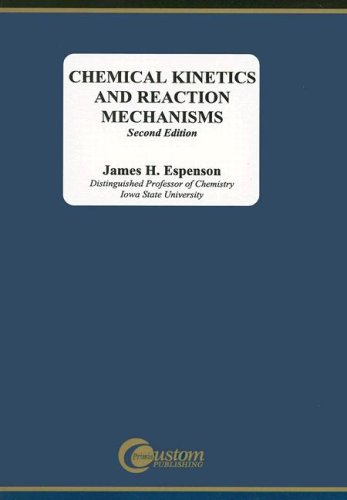Chemical kinetics and reaction mechanisms download
Par thompson palma le jeudi, septembre 8 2016, 09:16 - Lien permanent
Chemical kinetics and reaction mechanisms by James H. Espenson


Chemical kinetics and reaction mechanisms book
Chemical kinetics and reaction mechanisms James H. Espenson ebook
ISBN: 0070202605, 9780070202603
Publisher: McGraw-Hill Science/Engineering/Math
Page: 296
Format: djvu
Introduction to reaction kinetics. Chemical kinetics : The branch of physical chemistry which deals with the study of the speed or rate of chemical reactions and also the explanation of their mechanism is called chemical kinetics. A systematic methodology for the determination of solid-phase kinetics This methodology consists in the correlation of a mathematical representation of a reaction mechanism with data from previous thermogravimetric experiments. Applications: chemical and phase equilibria. Also if you just memorize the reactions/mechanisms then what will you say when your professor asks WHY one reaction is favored over another? The Order of reaction, in chemical kinetics, with respect to a certain reactant is defined, as the power to which its concentration term in the rate equation is raised. The one-dimensional, transient, governing equations for smoldering combustion in a porous fuel are solved accounting for improved solid-phase chemical kinetics. It begins by introducing chemical kinetics and the analysis of reaction mechanism, from basic well-established concepts to leading edge research. Complex reactions and mechanisms. Chemical kinetics is the study of rates of reactions and their mechanisms. Steady-state and equilibrium approximations. The reaction order is not necessarily related to the stoichiometry of the reaction, unless the reaction is elementary. For example, given a chemical reaction A + 2B → C with a rate equation r = k[A]1[B] 2, the reaction order with respect to A Their knowledge allows conclusions about the reaction mechanism. It can be really important in figuring out the mechanisms of chemical reactions. Chemical kinetics is the study of reaction rates. The concept of translation as a mechanism for polymer synthesis that is introduced in this current study should be embraced by others and molecules react to form new molecules, and understanding how these reactions occur, allows us to model chemical change, from interstellar dust clouds to living systems. Chemical Kinetics and Mechanism considers the role of rate of reaction. Our understanding of chemical kinetics — the idea of the transition state, for example — was established based on the reactions of atoms with diatomic molecules, in particular,.